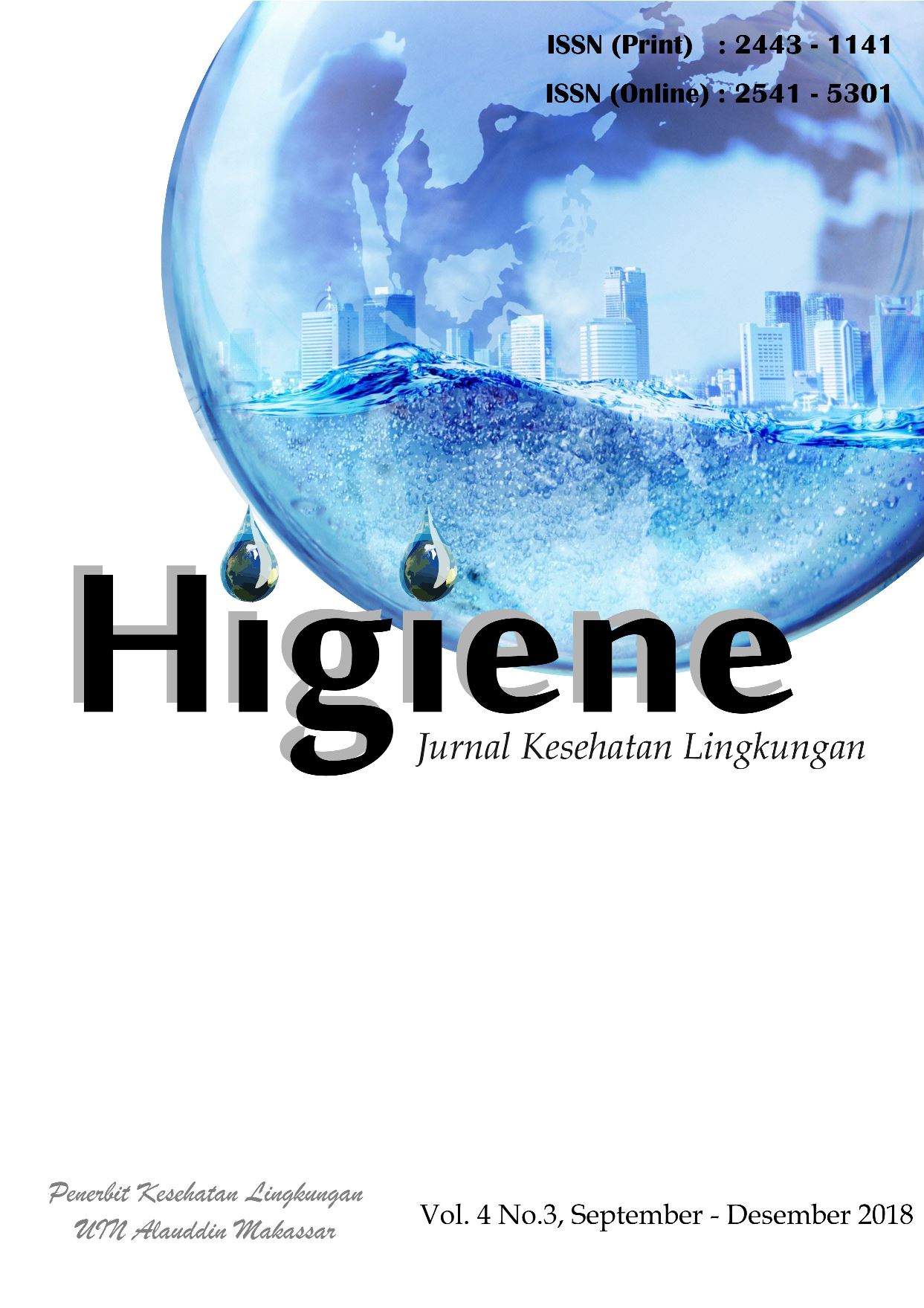Management Waste in The Public Service Area of The Southern Konawe Hospital
Abstract
Waste from such hospital activity is likely to result in pathogenic microorganisms and toxic chemicals that cause infection and may spread to hospital environments due to inadequate health care techniques, errors in the treatment of contaminated materials and equipment, and the provision and maintenance of sanitary facilities still not good, can cause the occurrence of transmission of diseases originating from waste and declining aesthetic value. Therefore, to improve the quality of hospital services, the need for proper waste management and in accordance with established procedures. This study aims to analyze the waste management in the Regional Public Service Agency of South Konawe District Hospital.
The type of this research is quantitative descriptive research. population in this research is all officer in charge of managing waste from start of room until to final disposal which amounted to 25 people. In this study using population research because the subject amounted to 25 people. The analysis used in this study uses descriptive analysis.
The results show that the problem that exists on the input aspect is the head of the sanitation installation is not a minimal Diploma Kesling. But the Nutrition Diploma. Officers sent for training are only ambulance coordinator and IPRS Coordinator while management staff never participate in specific training. In the input aspect, the budget for limba management is carried out efficiency so that there is still need from the unfulfilled waste management. In the process aspect, the problem related to the waste management process itself starts from the transportation process where the officers rarely use personal protective equipment, there is no special lane, the garbage is collected for several days to be burned, also the burning that is accommodated to wait for the third party to carry the transportation.
Expected To the South Konawe Hospital, it is necessary to consider following the Decree of the Minister of Health of the Republic of Indonesia Number 1204 / MENKES / SK / X / 2004 on the head of the sanitation installation is a minimum of Diploma 3 Environmental Health
Keywords : Hospital Waste Management, Input, Output; Process
References
Abdulla, Fayes, Hani Abu Qudais, Atallah Rabi, (2008). Site Investigation On Medical Waste Management Practices In Northern Jordan. Waste Management, 28, 450-458
Adisasmito, W. (2007). Sistem Manajemen Lingkungan Rumah Sakit. Jakarta: PT.Raja Grafindo Persada.
Astuti, A. (2014). Kajian Pengelolaan Limbah Di Rumah Sakit Umum Provinsi Nusa Tenggara Barat (NTB). Community Health, Volume II. No. I.
Aulia, A. (2012). Faktor-Faktor Yang Mempengaruhi Pengelolaan Sampah Medis Di Badan Layanan Umum Daerah RSUD dr. Zainoel Abidin Banda Aceh. Jurnal Kesehatan Masyarakat.
Azwar, A. (2010). Pengantar Administrasi Kesehatan, Jakarta, Binarupa Aksara.
Chandra, B. (2007). Pengantar Kesehatan Lingkungan, Jakarta, Penerbit EGC.
Dhani, M. (2011). Kajian Pengelolaan Limbah Padat Jenis B3 di Rumah Sakit Bhayangkara Surabaya.
Dirjen, P. D. P. 2004. Permenkes No.124/SK/X/2004. Persyaratan Kesehatan Lingkungan. In: plp, d. P. D. (ed.). Jakarta.
Entarina, W., Imam Argiono, Tommy Aramanda, Khairunnisa. (2014). Peluang Investasi Infrastruktur Bidang Pekerjaan Umum, Jakarta, Kementrian Pekerjaan Umum.
Febrina, R. (2011). Sistem Pengelolaan Sampah Padat di Rumah Sakit x jakarta tahun 2011.skripsi universitas indonesia :jakarta
Hapsari, R. (2010). Analisis pengelolaan sampah dengan pendekatan sistem di rsud moewardi surakarta. Undip.
Hasibuan (2009). Tinjauan Yuridis Terhadap Pengelolaan Limbah Bahan Berbahaya Dan Beracun (B3) di Rumah Sakit Umum Pusat H. Adam Malik Medan. Universitas Islam Indonesia, Yogyakarta, Universitas Islam Indonesia.
Herlambang (2016). Manajemen Pelayanan Kesehatan Rumah Sakit, Yogyakarta, Gosyen Publishing.
Keman, S. (2006). Evaluasi Pengelolaan Sampah Padat di Rumah Sakit Umum H. Surabaya. Jurnal kesehatan lingkungan, vol.3, 21-23.
Notoatmodjo, S. (2014). Ilmu & Seni Kesehatan Masyarakat, Jakarta, Rineka Cipta.
Nugroho S, Trihadiningrum Y. (2007). Kajian Pengelolaan Sampah Medis pada RSUD dr. Soedono Madiun. Prosiding Seminar Nasional Manajemen Teknologi V, Program Studi MMT-ITS: 2007 3 Pebruari. Surabaya
Paramita, N. (2007). Pengelolaan Sampah Rumah Sakit Pusat Angkatan Darat Gatot Soebroto. Jurnal Presipitasi, vol. 2 no. 1.
Patil, A. D., Shekdar, A. V (2011). Health-Care Waste Management in India. Journal of Environmental Management, 211-220.
Patrick. (2016). Sistem IPAL (Instalasi Pengolahan Air Limbah) [online]. Available: https://www.tanindo.net/ipal-instalasi-pengolahan-air-limbah/.
PLP, D. P. (2004). Permenkes No.124/SK/X/2004. Persyaratan Kesehatan Lingkungan. In: plp, d. P. D. (ed.). Jakarta.
Pruss, A. (2005). Pengelolaan Aman Limbah Layanan Kesehatan, Jakarta, Penerbit EGC.
RSUD Konawe Selatan (2017). Profil Kesehatan Rumah Sakit Kabupaten Konawe Selatan. In: Selatan, d. K. K. K. (ed.). Andoolo.
Satrianegara, M. F. (2016). Pendekatan Analisis Manajemen Kebijakan Dalam Pengelolaan Limbah Rumah Sakit. HIGIENE: Jurnal Kesehatan Lingkungan, 2(2), 62-66.
WHO (2005). Management of Solid Health Care Waste at Primary Health Care Centres, Geneva.
Wilson, D. G. (1997). Handbook of Solid Waste Management. New work.
Yulian, R. P. (2016). Evaluasi Sistem Pengelolaan Limbah Padat (Medis dan Non Medis) RS dr. Soedirman Kebumen. Semarang.
Copyright (c) 2019 HIGIENE: Jurnal Kesehatan Lingkungan

This work is licensed under a Creative Commons Attribution 4.0 International License.


